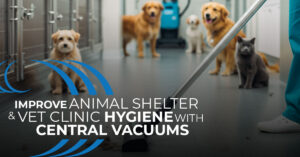
Boosting Productivity in Office Buildings with Central Vacuum
In today’s fast-paced work environment, maintaining a clean and organized office space is crucial for productivity. Office buildings often struggle with keeping their premises clean

A vacuum leak is one of the things that causes a central vacuum system to slow down.
Before using your central vacuum system, you must first make sure that none of the parts are leaking in order for your system to provide the vacuum suction required to capture and hold dust and debris. Otherwise, you’ll end up using an inefficient vacuum that scatters more dust into the air.
Here’s how to find a leak in a central vacuum system and how to fix it.
You can tell if there is a leak in your central vacuum system if it is showing the following symptoms:
How To Trace Leaks In A Central Vacuum System
The vacuum hose is the component most likely to spring a leak. Hoses get stretched farther than they should, or they become brittle and crack.
To find a leak, run your fingers over the surface of the hose. You may be able to feel a bump, a rough spot, or a slit that is allowing air to leak out.
If you didn’t find the leak, you will need to remove the hose from the vacuum, For canister vacuums, this is a simple process, but it can be more complicated on upright vacuums where one end of the hose is permanently attached. This usually requires unscrewing a panel to gain access to the hose coupling. Always refer to the user’s manual or search the manufacturer’s website for repair diagrams.
Take the hose to a large sink, bathtub, or outside to a bucket of water and fill the hose with water. Be sure to hold it from both ends so the water is trapped in the hose. With the hose in a U-shape, slosh the water back and forth until you can spot the area that is leaking.
If you cannot disconnect the hose from the vacuum, be sure to keep the motor components of the vacuum at a higher level than the water so that no moisture will enter the vacuum housing.
Small repairs can be made easily and let you get back to cleaning. However, the best solution is to replace the hose. Many home improvement stores carry replacement vacuum hoses, or one can be ordered from the manufacturer.
If the leak is located near the end of the hose, use a pair of pliers to remove the plastic connector from the end of the hose. Then, use a utility knife to cut off the end of the hose above the leak. Replace the connector and reattach the hose to the vacuum cleaner.
If you identify the loss of suction and it’s in a leaky inlet valve, you’ll want to start with unscrewing the inlet valve from the wall. If you need to remove any paint or wallpaper from the inlet, gently score around it with a knife to remove the paint or paper. This will safely remove the inlet and allow its complete removal from the wall.
Gently pull and twist to remove the inlet from the wall. You won’t need to remove or cut any wires, so make sure to leave those intact. Taking some electrician tape, place one or two good wraps around the neck of the valve. This will help build up the gasket that has likely deteriorated in older inlets.
Feed the wires back in safely, and twist the inlet back into place. Push it in firmly and parallel to the wall, and screw it back into place. This should help with air loss and help retain suction back in your vacuum system. If need be, go back in and place slightly more tape for added suction. One more go-around should do it.
One of the simpler ways to test for air leaks is to use regular soapy water. After isolating and pressurizing the system, use a brush to apply soapy water to all potential leaking areas. These include fittings and threaded areas. Anywhere where a leak is present, the soapy water will start to bubble. You can then mark these areas and move into fixing those leaks down the line.
Make sure to take care when pressurizing your vacuum system, as too much pressure can cause damage. O-rings and seals can become damaged if the pressure becomes too much.
Tape is another inexpensive way to test for potential leaks upon your vacuum system. Place pieces of tape on any suspected leaking areas and turn on your system. Any area that has leaks will cause suction, thus causing the tape to be deflected inward. Your system won’t need pressurization for the tape method to work.
Ultrasonic leak detectors work by detecting high-frequency sounds that are associated with air leaks. These detectors convert these sounds to an audible range that is then transmissible through headsets. The one issue with this form of leak detection is its susceptibility to background noise. Any amount of background noise can mask or obfuscate the noise of a leak.
A helium leak detector is an incredibly accurate way of detecting leaks through the use of helium. A sensor is placed by the vacuum’s inlet and used to detect any increase in concentrated helium in the airstream. Helium is then sprayed on any potential leaking spots, and if leaking, the helium gets sucked inward. The sensor then detects this movement of helium and alerts the user to a leak.

In today’s fast-paced work environment, maintaining a clean and organized office space is crucial for productivity. Office buildings often struggle with keeping their premises clean

Central vacuums in animal shelters & vet clinic: Explore how these systems boost hygiene, efficiency, and air quality.

In the world of home entertainment, a home theater is a luxury that many homeowners dream of. It’s an immersive experience that brings the magic

A central vacuum system is a significant investment that promises convenience, powerful suction, and improved indoor air quality. However, choosing the right central vacuum hose
Our home automation products are at the forefront of technology, offering a blend of convenience, security, and efficiency. As a Homewave dealer, you’ll be part of a network transforming homes into smart, futuristic spaces.
Embark on this rewarding journey with us and leverage the power of innovative technology.
Please fill out this form and become a Homewave Dealer.